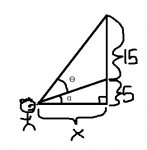bluester105
New member
- Joined
- Nov 27, 2011
- Messages
- 5
in a certain movie theater, the bottom edge of the 15 foot tall screen at the front is 5 feet above eye level. suppose we wish to sit so that the angle theta is as large as possible. how far should we sit from the screen?
so i made a diagram of what i am supposed to be looking for....
...|\
...|.\
15|...\ ...t=theta.
...|\....\
...|..\.t./\
...|....\/..\
5.|.......\..\
...|..........\.\
...|.............\\
...|_____x____| (sorry it looks better on paper....)
okay so what i dont understand is how i am supposed to incorperate x and theta into the same problem..i hope what i said makes sense...thanks for the help..
so i made a diagram of what i am supposed to be looking for....
...|\
...|.\
15|...\ ...t=theta.
...|\....\
...|..\.t./\
...|....\/..\
5.|.......\..\
...|..........\.\
...|.............\\
...|_____x____| (sorry it looks better on paper....)
okay so what i dont understand is how i am supposed to incorperate x and theta into the same problem..i hope what i said makes sense...thanks for the help..

